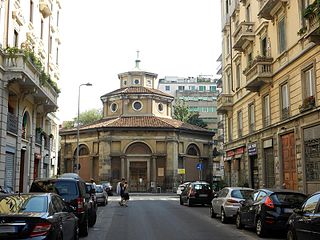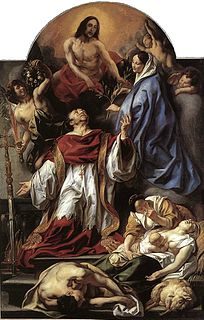
Charles Borromeo was the Archbishop of Milan from 1564 to 1584 and a cardinal of the Catholic Church. He was a leading figure of the Counter-Reformation combat against the Protestant Reformation together with Ignatius of Loyola and Philip Neri. In that role he was responsible for significant reforms in the Catholic Church, including the founding of seminaries for the education of priests. He is honoured as a saint by the Catholic Church, with a feast day on 4 November.

Line 3 is a subway line serving Milan, Italy. The line is part of the Milan Metro and is operated by ATM. Construction began in 1981 in order to be ready for the 1990 Football World Cup. It is also called the Yellow Line as it is identified by yellow signage.

Giovanni "Gio" Ponti was an Italian architect, industrial designer, furniture designer, artist, teacher, writer and publisher.

San Fedele is a Jesuit church in Milan, northern Italy. It is dedicated to St. Fidelis of Como, patron of the Catholic diocese of Como. Presently it remains a parish church, owned by the Jesuit order, though focusing on religious works.

Isidoro Bianchi called da Campione was an Italian painter of the Baroque period.

Italian Neoclassical architecture refers to architecture in Italy during the Neoclassical period (1750s–1850s).

Santa Maria Podone is a small Greek Orthodox church in central Milan, region of Lombardy, Italy.

Santa Maria Assunta is a Renaissance church in Genoa, Italy. It is located in a residential sector called Carignano located on the hills just above the city center, thus the church is also known as Santa Maria Assunta di Carignano.

Chiesa di Santa Maria al Paradiso is a church in Milan, Italy. It was begun in 1590 for the Third Order of Saint Francis, after designs by Martino Bassi. The facade, however, was only added in 1897 in a Neo-Baroque style by the architect Ernesto Pirovano (1866-1934).

Neoclassical architecture in Milan encompasses the main artistic movement from about 1750 to 1850 in this northern Italian city. From the final years of the reign of Maria Theresa of Austria, through the Napoleonic Kingdom of Italy and the European Restoration, Milan was in the forefront of a strong cultural and economic renaissance in which Neoclassicism was the dominant style, creating in Milan some of the most influential works in this style in Italy and across Europe. Notable developments include construction of the Teatro alla Scala, the restyled Royal Palace, and the Brera institutions including the Academy of Fine Arts, the Braidense Library and the Brera Astronomical Observatory. Neoclassicism also led to the development of monumental city gates, new squares and boulevards as well as public gardens and private mansions. Latterly two churches, San Tomaso in Terramara and San Carlo al Corso, were completed in Neoclassical style before the period came to an end in the late 1830s.

Leopoldo Pollack was an Austrian-born Italian architect who was active in Milan where he became one of the leading proponents of Neoclassical architecture.

Rodolfo Vantini was an Italian architect. He is remembered for his Neoclassical contributions to architecture in his native city of Brescia and in the surrounding regions of northern Italy. His masterpiece is the design of Milan's Porta Orientale customs offices.

The Porta Garibaldi, previously known as the Porta Comasina, is a city gate located in Milan, Italy, on the old road to Como. The Neoclassical arch was built to commemorate the visit of Francis I of Austria in 1825. It was reconstructed from 1826 to 1828 by Giacomo Moraglia and dedicated to Garibaldi in 1860. Built in the Doric style, the gate is flanked by two portals overlooking the street. The customs houses were added in 1836. Its less than monumental proportions are better suited to the surrounding streets as the gate used to be at the end of a winding road, hardly compatible with a grandiose project.

Ferdinando Albertolli was a Swiss-born Italian architect and a professor of design.

The Palazzo Saporiti, also known as Palazzo Rocca-Saporiti, is a historic Neoclassical mansion in the centre of the north Italian city of Milan.

The Palazzo Taverna is a late Neoclassical mansion in Milan, Italy, designed by Ferdinando Albertolli in 1835. It is located at 2, Via Montenapoleone, in the Porta Nuova district of the city.

Tirli is a village in Tuscany, central Italy, administratively a frazione of the comune of Castiglione della Pescaia, province of Grosseto. At the time of the 2001 census its population amounted to 284.

San Carlo al Lazzaretto is a small Renaissance style octagonal church now in largo Bellintani Fra Paolo, number 1 in the quartiere Porta Venezia of Milan. It is located about three blocks northwest of the Porta Venezia. Its present situation, amidst crowded 19th and 20th century apartment blocks, has little relationship to its original placement, in the central park of a massive rectangular cloister-like 15th-century leprosarium (Lazaretto). The church, once called Tempietto di Santa Maria della Sanità or San Carlino, escaped the late-nineteenth century demolition of the Lazzaretto.

There are three plague crosses in Brugherio, in the province of Monza and Brianza in Lombardy, in northern Italy. They were erected after the plague that struck Monza and its surrounding area in 1576. The crosses are three that remain of four that marked where there were four altars used to celebrate religious services during the plague. The plague of 1576 was in fact called "the plague of Saint Charles", given the Bishop's closeness to those affected. Information about the plague can be found in the Bishop of Milan, Saint Charles Borromeo's notes.





















